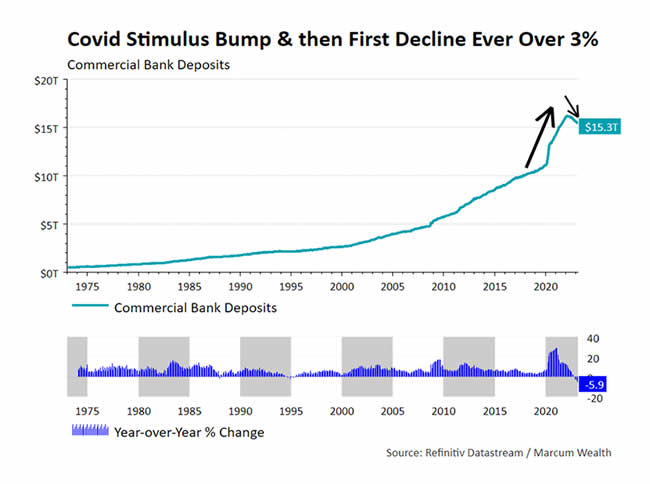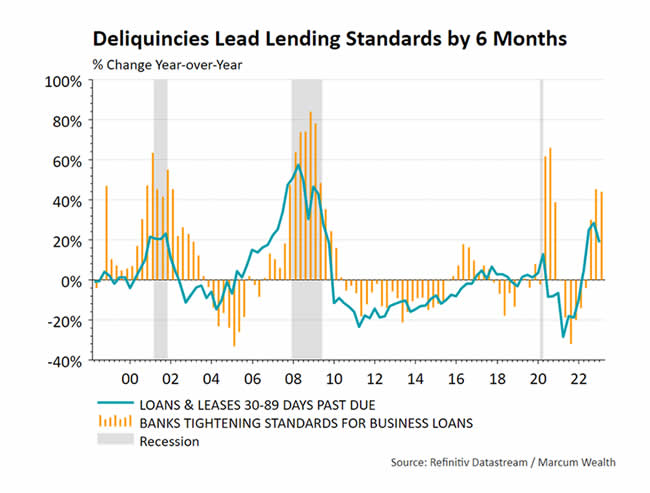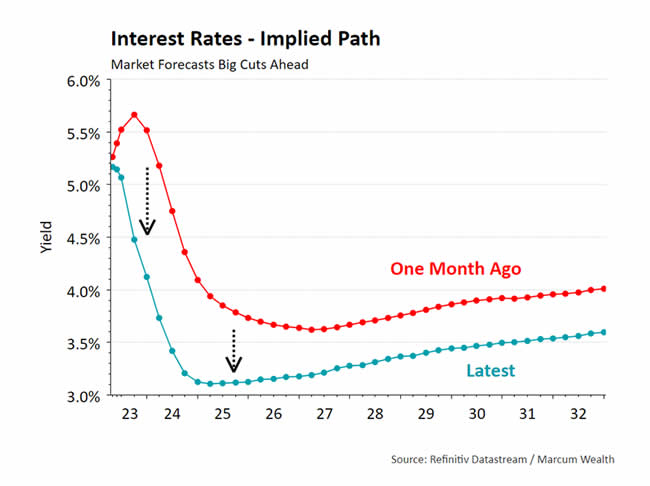
There is a lot to the story, but let’s keep it simple.
Fiscal stimulus during COVID helped avoid an economic depression. Much of the stimulus found its way to banks in the form of deposits by businesses and individuals. This consequence of low rates and stimulus stoked the fire that led to today’s high rate of inflation.
To fight inflation, the Fed raised rates at the second fastest pace since 1970 and when interest rates rise, bond portfolios fall in price.
Under these circumstances, the loans and bonds that banks acquired at previously low rates are on their books as an unrealized loss. Even though the principal will be paid back on treasury and agency mortgages, there is a temporary decline in price when rates rise. As borrowers defaulted in 2008, the principals due on subprime loans were not going to be paid back. Thankfully, that’s not the situation we face today.
To make a spread and increase earnings, banks pay a lower deposit rate than they charge for a loan. As the Fed raised interest rates, Treasury bills and money market funds paid more than bank deposits, leading to deposits leaving banks for Treasury bills and money market funds.
This is a new development in the history of banking. Deposits declined by nearly 6% from a year ago.

Silicon Valley Bank (SVB) and Signature Bank experienced a classic run, where depositors pulled funds after learning about the banks’ shaky balance sheets. To tamp down any potential for broader panic, the Fed and Treasury guaranteed that all deposits, even those exceeding the $250,000 FDIC limit, would be safe. Last week, Chairman Powell, trying to further ease any sense of panic, said “all depositors are safe,” even though it’s the Treasury and Congress that have the power to make that guarantee. The authorities will always do what they feel is necessary to prevent financial contagion, so we take him at his word.
According to reports, executives at SVB and other executives lobbied Congress to ease regulations on banks, including liquidity and capital requirements. This increased the threshold to $250 billion for tougher stress tests, which both SVB and Signature Bank fell below. In hindsight, the tests could have been valuable to regulators and investors.
Over the past year, late loan payments increased from low absolute levels. Lenders are already near recession levels in terms of tightening credit. With deposit outflow risk, and having just seen two major domestic banks fail, credit is likely to continue becoming scarcer and more expensive.

The Federal Reserve raised interest rates to 5% last week. Chairman Powell remains focused on the fight against inflation while trying to protect the stability of the financial system.
The bond market changed its path with respect to interest rate hikes. A month ago, higher rates were expected into 2024. Now, the yield curve suggests interest rate cuts are ahead. The Fed has only noted that, for 2023, “some additional policy firming may be appropriate.” The path they ultimately choose will depend on how embedded inflation proves to be and their read on overall financial stability.

For now, short-term cash can earn a decent return in Treasury bills, Certificates of Deposits (CDs), and money market funds. It seems we are only in the early stages of the financial sector’s adaptation to higher interest rates. From what we’ve seen so far, it appears industries and businesses relying on debt will face a challenging financing environment ahead. The good news is that by raising interest rates, the Federal Reserve has created room to cut interest rates when an economic slowdown happens.
Important Disclosure Information
Please remember that past performance may not be indicative of future results. Different types of investments involve varying degrees of risk, and there can be no assurance that the future performance of any specific investment, investment strategy, or product (including the investments and/or investment strategies recommended or undertaken by Marcum Wealth, or any non-investment related content, made reference to directly or indirectly in this commentary will be profitable, equal any corresponding indicated historical performance level(s), be suitable for your portfolio or individual situation, or prove successful. Due to various factors, including changing market conditions and/or applicable laws, the content may no longer be reflective of current opinions or positions. Moreover, you should not assume that any discussion or information contained in this commentary serves as the receipt of, or as a substitute for, personalized investment advice from Marcum Wealth. Please remember to contact Marcum Wealth, in writing, if there are any changes in your personal/financial situation or investment objectives for the purpose of reviewing/evaluating/revising our previous recommendations and/or services, or if you would like to impose, add, or to modify any reasonable restrictions to our investment advisory services. Unless, and until, you notify us, in writing, to the contrary, we shall continue to provide services as we do currently. Marcum Wealth is neither a law Firm, nor a certified public accounting Firm, and no portion of the commentary content should be construed as legal or accounting advice. A copy of the Marcum Wealth’s current written disclosure Brochure discussing our advisory services and fees continues to remain available upon request. Please advise us if you have not been receiving account statements (at least quarterly) from the account custodian.
Historical performance results for investment indices, benchmarks, and/or categories have been provided for general informational/comparison purposes only, and generally do not reflect the deduction of transaction and/or custodial charges, the deduction of an investment management fee, nor the impact of taxes, the incurrence of which would have the effect of decreasing historical performance results. It should not be assumed that your Marcum account holdings correspond directly to any comparative indices or categories. Please Also Note: (1) performance results do not reflect the impact of taxes; (2) comparative benchmarks/indices may be more or less volatile than your Marcum accounts; and, (3) a description of each comparative benchmark/index is available upon request.
